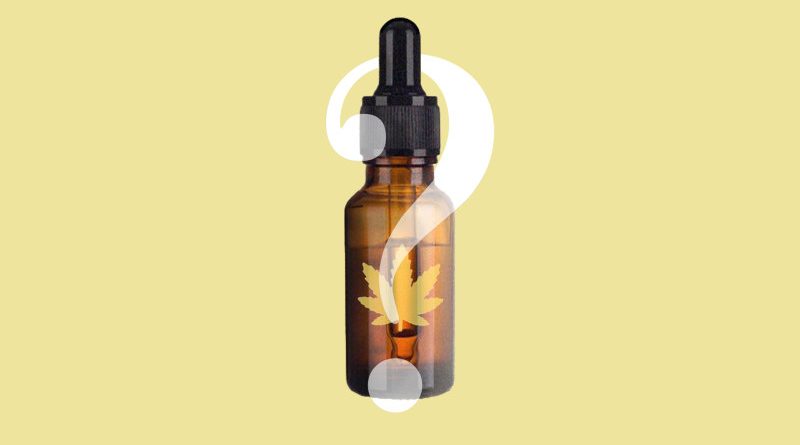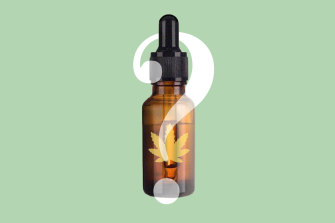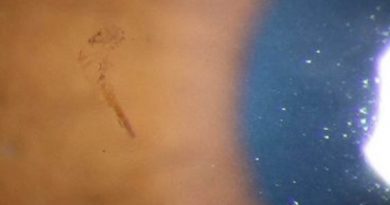CBD oil is having a moment. What’s it for and what’s behind all the hype?
If you believe all of its apparent virtues, CBD oil can fix just about anything. It stimulates the same response as social contact, chocolate and exercise. But what does the science say, and is it legal in Australia?
If you believed all the hype extolling its apparent virtues, CBD oil just might be the elixir of life. The cannabinoid compound is having a moment, with its global market projected to grow from $US1.4 billion in 2020 to $US12.9 billion by 2027, according to one market research group.
A 2020 analysis that looked at social media posts to better understand why people used the plant extract found reasons ranging from mental health issues, including anxiety and depression, to musculoskeletal problems as well as for gut issues, autism, addiction, heart problems, skin problems, eye problems, sleep and sexual health issues.
This was despite a lack of evidence behind many of the claims about CBD oil’s benefits and, in many cases, a lack of access to the real thing. A separate analysis found that only one-third of extracts sold online contained the amount of cannabidiol (CBD) that the label claimed – if they contained any at all. University of Newcastle clinical pharmacologist Professor Jennifer Martin recalls a patient who was “really pissed off” because he spent $90 on what he believed was CBD oil only to discover it was olive oil.
Whether the products or claims are real or not, the hype surrounding CBD oil certainly is. So, what is it? Where does it come from? And does it do anything?
Illustration: Jo GayCredit:
What exactly is CBD oil (and will it make me high)?
There are about 100 different cannabis-like (cannabinoids) compounds in hemp and cannabis plants. The two main ones are tetrahydrocannabinol (THC, found mostly in cannabis), which will make you high; and cannabidiol (CBD, found mostly in hemp), which will not make you high nor have psychotic effects. As the World Health Organisation states, “in humans, CBD exhibits no effects indicative of any abuse or dependence potential.”
Both THC and CBD fall under the umbrella of “medicinal cannabis”, which can contain THC only, CBD only, or various ratios of the two.
Although hemp has a higher CBD content, hemp oil is very different to CBD oil. Hemp oil is made by cold-pressing hemp seeds. CBD oil is made by extracting the compound from the hemp plant and then mixing it with a carrier oil. You can buy hemp seed oil at the supermarket to drizzle on your salad but it contains a negligible amount of actual CBD.
In CBD oils, the amount of cannabidiol varies from product to product. There is “purified” CBD, typically at least 98 per cent pure, and “full spectrum”, which contains other compounds from the plant, not just CBD.
“The purified preparation is the one that has been approved by the TGA [for epilepsy],” says associate professor Jonathon Arnold, the deputy academic director of the Lambert Initiative for Cannabinoid Therapeutics, a research centre at the University of Sydney set up with an investment by Barry and Joy Lambert, whose granddaughter suffered from debilitating paediatric epilepsy. Arnold adds that the full-spectrum preparations may be beneficial in their own right but need further research.
People have been using cannabis and its compounds for millennia, first documented in the case of Emperor Shen Nung in 2800BC.
In the 1800s, cannabis extracts, including CBD, were being used in Western medicine, but prohibition put a stop to that (Australian federal laws banned cannabis importation and use in 1926). People continued smoking marijuana and extracts were made and sold illegally. So, why the sudden interest in these compounds now?
The “father of cannabis”, Israeli researcher Raphael Mechoulam, discovered THC in the 1960s and then made other groundbreaking discoveries in the ’80s and ’90s, identifying the various cannabinoids in cannabis as well as the endocannabinoid system (ECS). The ECS is the naturally occurring cannabis in our bodies – made up of molecules, receptors and enzymes – that plays a role in regulating mood, motivation, pleasure, sleep, appetite and metabolism.
It wasn’t until 2015, that Australia’s Therapeutic Goods Administration (TGA) approved CBD as a prescription medicine.
Unless it is prescribed by a doctor, people who want CBD have to obtain it elsewhere, including buying unregulated products online from overseas suppliers.
Is it legal in Australia, and where is it sold?
In recent years, there has been a proliferation in research and a corresponding surge in supply and demand for the product. Low-dose CBD has since been approved as a Schedule 3 (pharmacist-only) medicine, and in 2021 Australia’s largest pharmacy chain, Chemist Warehouse, signed a deal to supply the products over the counter. But you won’t see them in any pharmacy yet. This is because no CBD product has been approved by the Australian Register of Therapeutic Goods (ARTG), which is a requirement of pharmacist sale. When, and if, ARTG gives its approval, “low-dose” CBD products (less than 150 mg per day), from companies that also have TGA approval, will become available over the counter in pharmacies.
Until then, doctors can prescribe it for a range of issues including epilepsy, chronic pain, anxiety and insomnia. Otherwise, people who want CBD have to obtain it elsewhere, including buying unregulated products online from overseas suppliers. Mail-order and online cannabis products are illegal in Australia.
It is, Arnold admits, “all quite complex”.
In many countries, CBD is available as an over-the-counter “nutraceutical”. These contain very low doses (just a fraction of the therapeutic dose range) for which there is little evidence of health benefits. The lack of therapeutic effect with such low-dose products is not the only issue, says Professor Stephen Myers, a complementary medicine expert from the NICM Health Research Institute.
“Obtaining your CBD oil other than through a medical prescriber is fraught with a number of problems,” Myers says. “The preparation is unlikely to have been manufactured under pharmaceutical-grade quality.”
And what you might think is pure CBD oil could have contaminants including, but not limited to, THC. “A lot of people don’t want the psychoactive effect of cannabis, they’re more after the anxiolytic effect – the reducing anxiety effect.“
OK, so why are people so excited about CBD?
CBD is what pharmacologists like to call a “promiscuous drug”, explains Arnold.
It is referred to as a “promiscuous drug” partly because the endocannabinoid system (ECS) is widespread in the body and CBD seems to interact with a variety of its target receptors and enzymes.
“CBD is a really interesting compound because there have been more than 65 different potential mechanisms of action that it has,” Arnold says. “CBD doesn’t directly activate the cannabinoid receptors. It might be boosting your endocannabinoids.”
Our endocannabinoids interact with cannabinoid receptors to influence biological function. When we boost our levels of endocannabinoids (endo means “within”), this may result in less inflammation and pain in the body, an enhanced sense of wellbeing and support the body to regulate its functions.
“Ananda is the Sanksrit word for bliss – and it increases levels of anandamide clearly in the body.”
“[The ECS] is all through the brain and in the immune system and in most parts of the body,” says pharmacologist and cannabinoid researcher Mark Connor from Macquarie University. “It has a zillion functions. It’s in parts of the brain that are important in anxiety, it’s in parts of the brain that are important in mediating reward, it’s in parts of the brain that are important in modulating pain.” He adds: “Any drug that interacts with that system has, potentially, a wide range of effects.”
By taking CBD oil, we boost our blood levels of endocannabinoids, Arnold says. “One of them is called anandamide – ananda is the Sanksrit word for bliss – and it increases levels of anandamide in the body,” he explains. “The idea then is that you’re toning up these levels of naturally occurring endocannabinoids and that could be exerting its beneficial effects.”
Social contact, chocolate and exercise can also stimulate anandamide.
CBD also has anti-inflammatory properties and, Arnold adds, inflammation can be common to a range of different health conditions.
He says CBD also behaves similarly to Valium “but it’s not as potent, and it acts on this inhibitory receptor called the GABA receptor, and it’s able to tone up the actions of that receptor.” GABA receptors help to inhibit or reduce nerve impulses and have a natural calming effect.
(Alcohol ultimately depletes GABA stores, and because these stores have a calming function, this results in anxiety.)
But does it work?
There is good evidence that CBD does help with epilepsy by reducing seizures, and this is what it is approved for medically.
Australian Medical Association president Dr Omar Khorshid points out that only two medicinal cannabis products have been approved by the TGA and registered on the ARTG: “Nabiximols (for patients with moderate to severe spasticity due to multiple sclerosis) and Epidyolex (for seizures associated with Lennox-Gastaut syndrome or Dravet syndrome).”
All other medicinal cannabis products available in Australia are unregistered medicines. Still, legal access to medicinal cannabis is increasing and GPs can prescribe a range of CBD oils via the Special Access Scheme or Authorised Prescriber Schemes for different conditions, including neuropathic pain, chronic pain, anxiety and insomnia.
As far as the evidence for these uses goes, there is emerging data suggesting it may help with anxiety, it has been approved in several countries for the treatment of pain caused by inflammation, and one review found it “could improve” sleep quality, but, this is based on the limited research and too early to say for sure.
Researchers continue to explore its use in other areas.
“It’s interesting because it seems to have so many benefits for symptoms that are troubling people – weight, sleep, appetite, mood,” Martin says. However, none of the evidence for this is solid yet.
Nor is the research that has explored its use for Parkinson’s disease (“interesting evidence” but currently insufficient, according to a 2020 review paper); burnout (it can help, according to one small new study); and as a treatment for addiction (one randomised, controlled trial found it was safe and more effective than a placebo).
“A lot of the things people would like to think it’s effective for, the evidence is very slim and a lot of it is just not there at all. The evidence for and against the usefulness is coming.”
Despite the lack of good evidence, some people take CBD oil daily as a prophylactic, for sleep and reducing anxiety: the reason more than 60 per cent of CBD users took it, according to a survey of 5000 people – by a cannabis market research group – reported in The New York Times.
For now, Khorshid is unconvinced of its benefits. “Currently, there is insufficient evidence to use medicinal cannabis products more broadly and the evidence base varies across conditions. This is why there are not more medicinal cannabis products registered on the Australian Register of Therapeutic Goods,” he says.
“The TGA states that medicinal cannabis is not appropriate for individuals with an anxiety disorder. The TGA also states that there is no evidence on its effects on sleep.”
Connor says, “A lot of the things people would like to think it’s effective for, the evidence is very slim and a lot of it is just not there at all. The evidence for and against the usefulness is coming. In a few year’s time we will have a much better idea about what benefits it might have.”
Are there side effects?
A landmark study on how cannabis affects driving ability has shown that CBD does not impair driving. People who are taking CBD-only products are legally allowed to drive, although Martin urges caution given that it’s used to help people with sleep issues, and seizures. It is illegal to drive while being treated with products containing THC.
“It is quite a safe drug,” says Arnold, noting that meta-analyses have found the main problems are that it can cause diarrhoea – and that it can interact with other drugs. “That needs to be better documented, so clinicians have good guidance on how to manage those interactions.”
Martin agrees: “It does seem to have a lot of potential benefits but there’s a need to understand it more as well.”
And while CBD seems to be “generally reasonably safe in healthy people at low doses”, according to Connor, “the fact that it’s probably harmless probably means it’s not doing very much either.”
He points out that the doses to treat a condition, such as epilepsy, are much higher than people are likely to take daily.
“It’s like any drug, if you take a little, it’s probably fine … taken at higher doses it could be problematic.”
If you think CBD may benefit you, speak with your GP.
“What’s a good combination for epilepsy may not be a good combination for pain,” Connor says, and doses and combinations my differ, depending on why it’s being used. “It’s a very complex space.”
“Even if it does turn out to be effective, it’s never going to be: ‘Here, take 100 milligrams of cannabidiol and that’ll fix what ails you’.“
Fascinating answers to perplexing questions delivered to your inbox every week. Sign up to get our new Explainer newsletter here.
If you'd like some expert background on an issue or a news event, drop us a line at [email protected] or [email protected]. Read more explainers here.
Most Viewed in Lifestyle
Source: Read Full Article




